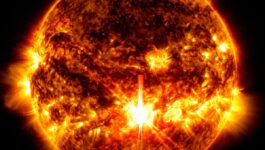
Inversion of the solar magnetic field: maximum reached, other eruptions and auroras soon!
On October 3, 2024, the Sun emitted its biggest X-ray flash in years. It was heading straight towards Earth! © NASA / SDO
We have had at least several episodes of northern lights at low latitudes, including two visible as far as the south of France and lower. And it's not over yet. NASA Goddard (named after this aerospace pioneer) confirmed Thursday that the solar maximum had just been reached with the reversal of the magnetic field of our star. Its accompanying video is impressive, as always:
Let's try to see it more clearly
One of the best indicators of the Sun's activity remains its sunspots. These are regions where the magnetic field is very active. Their black color is only a contrast effect due to the temperature differential between the photosphere, which is approximately 5500 °C, and the spot itself, 2000 °C less hot. The more spots there are, the closer they get to the equator and the closer the cycle is to its maximum.
Impressive sunspot group from October 3, 2024 © Space Weather, NASA SDO
Number of sunspots during solar minimum and maximum. © NASA / Goddard Space Flight Center
Here is a magnificent video of the appearance and evolution of a group of sunspots from three animations designed by Pascal Paquereau with a 254 mm telescope equipped with an Astrosolar solar filter* of density 3.8:
Group of sunspots from 10/20/2024: we note that they are all near the equator, which is a characteristic of the maximum of the cycle. © Space Weather, (Nasa, SDO)
What is a reversal of the solar magnetic field? Is it dangerous?
We are in the midst of a reversal of the solar magnetic field. © Wilcox Solar Observatory
The Sun is made of moving plasma. A plasma is an electrically charged material, not neutral like so-called “ordinary” matter. Thus, the rotation of our star on itself produces a magnetic field by dynamo effect. The Sun makes a complete revolution in about 25 days, which may not seem like much compared to the Earth, but it is 109 times larger with a diameter of about 1,390,000 km, or about 7,190 km/h rotation speed. Not so slow, man!
The magnetic field generated is therefore very complex, here is a diagram:
Image taken from a CEA video on the solar magnetic field. © CEA
Let the most anxious be reassured: the solar magnetic poles have always reversed and there is no real risk for us; you will just have to take advantage of the polar auroras caused by solar eruptions which are still very frequent for about a year. Of course, if you have a network of satellites, there are risks when our star emits a big X flashlike about twenty days ago.
CMe, or coronal mass ejection. © US National Oceanic and Atmospheric Administration
A solar flare. © NASA Sun and Space (gif made on Ezgif.com)
If you want to be informed in real time about the chances of seeing — and photograph — magnificent northern lights, such as those of October 10, we advise you to follow certain X-(Twitter) accounts, including those of NotreEspace (the author of these lines) Or Astrostone.
And as we never tire of it, some photos taken in France of the last northern lights from the now famous episode of October 10, 2024:
© Sylvain Gairaud & Brice Haziza
Show EXIF
This argument is unfortunately disconnected from any objective scientific reality, in particular because solar cycles are one-decadal (11-year cycles) while the increase in temperatures has been continuous since the industrial era.
More Info





